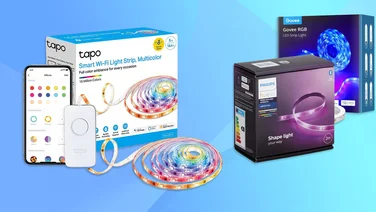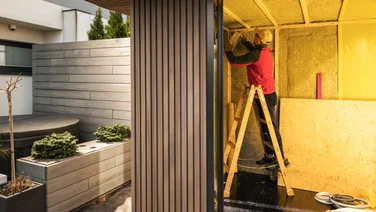To help us provide you with free impartial advice, we may earn a commission if you buy through links on our site. Learn more








- Slick, fully-featured app
- Great lighting with rich, vibrant colours
- Huge selection of lamps, lights and bulbs
- Good support for third-party bulbs and apps
- Bulbs can get expensive
- Hue Sync doesn't work on the platforms or services where you want it most
Update: In May 2019, Philips added a new Zones feature to the Hue app, changing the way you can organize your lighting. Does it make the Hue system even stronger?
Our original review continues below:
Philips was a colour lighting pioneer with Hue, and it continues to push smart lighting further than just about anyone else. Its range now extends from basic white bulbs through to table-lamps, exterior lighting, lighting strips and compact wall lights. Better yet, where other manufacturers are still catching up on app support, Hue now has features like colour-sync to music, TV and PC gaming. If you want to go beyond the smart lighting basics, Hue seems the best way forward.
Philips Hue review: Installation
Like most smart lighting systems, a Hue setup is built around a hub – either Philips’ own Hue Smart Bridge 2, Samsung’s SmartThings Hub or the hub built into the Amazon Echo Plus. Setting up bulbs without the Smart Bridge 2 is perfectly doable, but you’ll miss out on the Hue app and some of the more advanced features, including Hue Sync support and support for scenes and sensors. You’ll get a solid lighting system, but not the whole shebang.
In any case, you won’t have any issues installing the Smart Bridge. It connects directly to your router over Ethernet and from there you just need to install the iOS or Android app, create your Hue account, then press the button on the Smart Bridge to link it to the app. You can configure Siri and HomeKit if you’re an iOS user, and from there it’s a simple case of adding your various bulbs and lights.
If you’re using first-party bulbs and lamps this is easy, though you have to get your head around the way ZigBee wireless networks work. This power-efficient network technology is very stable once set up, but it relies on ZigBee devices connecting through one another in a mesh rather than directly to a central point, as would happen on a conventional Wi-Fi network.








As a result, you might find that adding Hue bulbs to the lamps and fittings in one side of the house, then hoping to include a lamp on the other side gets you nowhere. In the case of one Hue bulb, we found it easier to install the bulb on a standard lamp next to the Smart Bridge before moving it to an upstairs socket, than to get the Smart Bridge to find it in its final position from the off.
All the same, we had our first four-bulb Hue setup up and running within around half an hour of unboxing, and we’ve added additional Hue and third-party bulbs and lamps fairly easily since. Hue products tend to link first time when they’re in range, while third-party bulbs sometimes need the lamp trick mentioned above but, otherwise, we’ve found no connection problems provided we don’t keep moving bulbs around.
Philips Hue review: Bulbs and Accessories
Hue’s lighting range is so extensive that it’s impossible to cover all the bases. You’ve got your basics – dimmable white bulbs, colour temperature tunable white bulbs and full-colour RGB bulbs – but also glowing LED strips, compact colour-changing table-lamps (the Hue Bloom), portable table lamps with a built-in battery (the Hue Go), flush ceiling lights, outdoor lanterns and a whole lot more.








Other manufacturers are catching up, offering GU10 spotlights and E14 candle bulbs, but if you want the full range of lighting to cover every room and space in and around your home, then Hue is by far your best option.
What’s more, Hue’s lighting is a notch above the competition. Sure, white bulbs and tunable white bulbs are much of a muchness, but if you want a wider range of richer colours, not to mention colours that match what you select on the colour picker, then Hue is streets ahead.
Hue also wins on the accessories front for the simple reason that you get not just indoor and outdoor motion sensors but wireless switches, too. The latter are battery powered and can be programmed to perform different functions with different numbers of clicks, allowing you to turn on all the lights in your house from a single control, or switch between different lighting levels with two or three clicks.
Another strength is its support for third-party bulbs via ZigBee, with Innr in particular selling bulbs at lower prices to fill out your Hue setup. These bulbs don’t always support the full range of Hue features or deliver the exact same quality of light, but it’s a good way to save money in rooms where you don’t spend so much time or you just want a simple white light. Philips’ own bulbs can get pricey as you move up the range, after all.
Philips Hue review: Rooms, zones, scenes and routines
The Hue app has become one of the system’s biggest strengths, making it easy not just to add and control lights, but to configure them into rooms and zones. This is the key to making the most of your smart lighting setup. Bulbs and lights are added individually, but accessed through a room-by-room interface, where you can quickly tap lights on or off, or use a slider to alter their brightness without having to leave the page. You can also adjust the colour or tone of any coloured or tunable lights using a simple colour picker, with separate pickers for each lamp or bulb.








Until recently, lights could only be controlled individually or room by room, but the May 2019 update added a new way to group them: zones. You can set up zones to manage any group of lights you want, whether you want to control a wider group of lights across multiple rooms – for instance, all your upstairs lighting – or a smaller group of bulbs and lamps inside one room. This is handy, not just for turning, say, all your upstairs devices on or off at once, but also for defining a group of lights around your TV or in an area where you like to read.
Both rooms and zones can also be configured through ‘scenes.’ Philips has already defined presets for Bright, Dimmed and Nightlight, and you can easily create custom scenes for watching movies, reading, cooking or throwing a party. Once you’ve set up a scene you can select it with a tap or (with the appropriate smart speaker) using Google Home or Alexa. This makes the more granular control you get with zones even more useful, as you can set up scenes to control the lighting around your TV without affecting other lighting in the living room, and even work these through automated routines.
Routines are where the real power of Hue kicks in. You can set lights to come on and off at set times, with specific white tones or colours and fading in or out over specific periods. If you want an easy wake-up with a slow fade-in and comfortable warm lighting, add the right tunable bulb and Hue has you covered.
You can also set timers so that a light comes on, goes off or blinks after a set period, or use geofencing to turn the lighting on or off as your phone enters or leaves the proximity. You can set-up holiday lighting to simulate lights going on and off while you’re away, but it’s a shame that Hue doesn’t have this as a preset, as Hive does with its Mimic feature.
Meanwhile, you can add accessories like the dimmer switches or motion sensors and define what happens when they’re activated. You can also customise the sensitivity of the latter
Philips Hue review: Third-party apps and Sync
It’s all very easy to use and program, without the rough edges you’ll find in the Hive system and app. However, Hue goes one better by delivering more of an ecosystem for its own apps and for third-party developers, which extends what Hue can do. Several third-party apps out can control Hue lighting, either with different configuration options or music sync features that transform your living room into a disco. Philips itself has the most exciting option, though, with the combination of the Hue Entertainment settings within the main Hue app and the Hue Sync macOS and Windows 10 apps.








This allows you to set up entertainment areas with a lighting equivalent of surround sound, by dragging the lights around a simple 2D plan to define front-left, front-right, rear-left and rear-right positions (provided you have enough lights). The Windows 10 and macOS apps can then sync your lighting to either reflect what’s playing on its speakers (or any connected speakers) or display (or a connected TV).
The effect can be surprisingly immersive, as the lights don’t just replicate the colours in games and movies, extending them beyond the screen, but even track colours as they move from left to right across the picture. It’s not quite surround sound for the eyes, but it makes the experience bigger and more cinematic, and the actual syncing is often very tight.
Yet there’s a feeling that Philips has dropped the ball here. For one thing, it would be great if Hue Sync ran on other platforms, like consoles or smart TVs, that you usually use for watching movies and TV or playing games; we’d love to use it with an Xbox One X. For another, it’s very fussy about anything with content protection, so Netflix and Amazon Prime Video, to name two obvious services, won’t play ball. And would it really hurt to get Sync working – even imperfectly – on third-party coloured bulbs?
Philips Hue review: Voice Assistants
Hue works well with Amazon’s Alexa provided you remember that you have to add the necessary skill, then add the devices to Alexa to get all your different rooms and scenes set up for voice control. Once done, you can set brightness levels, adjust the tone or change colour, or even switch from scene to scene using voice.
You can’t ask Alexa to turn the lights on at a certain time – she just switches them on straight away – but it’s easy enough to configure your lighting for the there and then. It’s much the same story with Google Home. Once you’ve linked the Home app to your Hue account you can easily turn lights on or off and switch scenes on command.
Philips Hue review: Verdict
It’s not the cheapest way to get started with smart lighting and it doesn’t have the wider smart home ecosystem of Hive, but if you’re looking for the richest, most comprehensive smart lighting system, then Hue is it. You’ll have a wider range of bulbs, lamps and lighting, a slicker and more feature-packed app, more options in terms of third-party apps and third-party bulbs – and the most vibrant tones and colours.
Philips could improve in terms of scheduling and holiday lights, and while Hue Sync for Entertainment is a nice idea it’s in desperate need of more support for the devices and services you actually want to use in your living room. All the same, this is a great system, which is flexible enough to let you use the lights you want in the way you want – and a great first step into a smarter living space.
| Buying options | |
|---|---|
| Starter kit (£65) | Buy now from Amazon |
| White and Colour Ambience starter kit (£135) | Buy now from Amazon |
| White 60W equivalent bulbs (£15) | Buy now from Amazon |
| White Ambience bulbs (£25) | Buy now from Amazon |
| White and Colour Ambience Bulbs (£45 to £50) | Buy now from Amazon |








